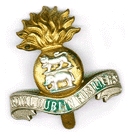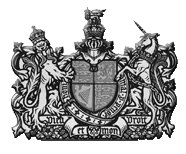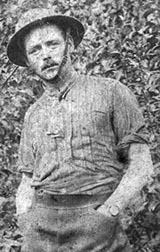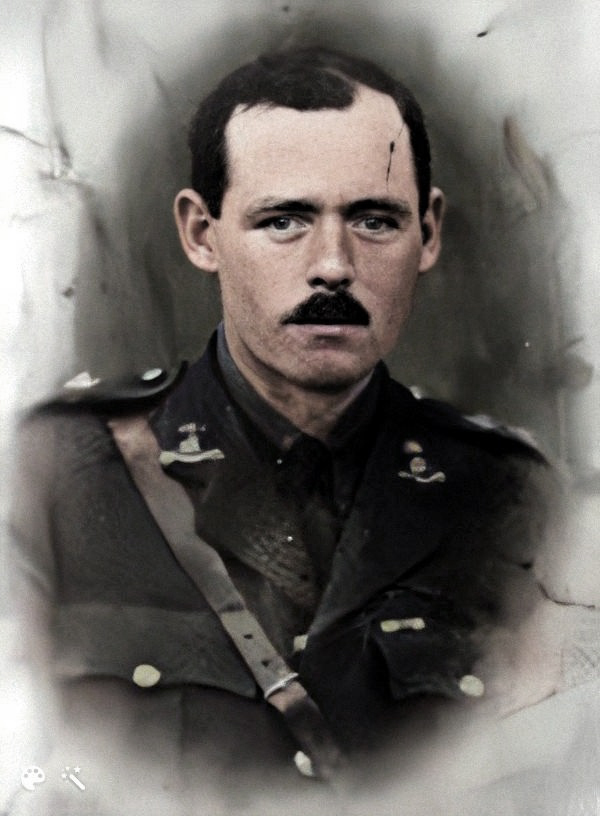 War Diary
War Diary8th Royal Dublin Fusiliers
Place: Left Sub Section Puits 14 Bis Section
Date: April 27, 1916
Gas attack was signalled back from A Coy at 4.45a.m. There was an almost imperceptible breeze from the EAST.
A dense cloud of black gas and smoke was between us and the sun and gradually spreading over our lines; at 5.20a.m. a heavy bombardment of our front line trenches began during which time heavy rolls of whitish gas was seen to come from all the sap heads in front of Hulluch subsection and the POSEN CRATER and pass over the lines of the 49 Inf Bde on our left; the bombardment gradually lifted to our reserve and communication trenches and under the guns the enemy entered a section of our front trench where nearly all the men were killed or wounded; they were put out again and the line held for the rest of the day by the remnants of the two coy reinforced by B Coy from the reserve trench and later (at dark) by A Coy of 9 DUBLINS from GUN TRENCH.
A Coy 8 DUBLINS now had about 20 effectives and D 45. Casualties attached. The night passed in evacuating wounded and burying dead & identifying where possible. Our guns put up good shooting and at 5p.m. put up a strong barrage.

 The London Gazette,
The London Gazette, June 24, 1916
His Majesty the KING has been graciously pleased to confer the Military Cross on the undermentioned Officers and Warrant Officers, in recognition of their gallantry and devotion to duty in the field:-
Temp. 2nd Lt. Peter John O'Connor,
8th Bn., R. Dub. Fus.
For conspicuous gallantry. By his personal influence and good leadership he repelled two hostile attacks on his trenches under very trying conditions.
 War Diary
War Diary8th Royal Dublin Fusiliers
Place: Left Sub Section Hulluch Section
Date: August 1, 1916
Hour: 00.01am
Raid rendered abortive last night was repeated on night of July 31st–August 1st. Covering party under 2/Lt. P.J. O'Connor left our lines by MULLIGAN'S SAP at 12 midnight & took up
 position. Bangalore Detachment followed and then assault party. Lt. D.R. Tittle (2nd Dublins) led charge of the former and 2/Lt. Dunn was i/c of the latter assisted by 2/Lt. McElnay. All parties out by 12.40a.m.
position. Bangalore Detachment followed and then assault party. Lt. D.R. Tittle (2nd Dublins) led charge of the former and 2/Lt. Dunn was i/c of the latter assisted by 2/Lt. McElnay. All parties out by 12.40a.m.Heavy engagement was going on on our LEFT in The Chinchy Sector at the same time. A raid by the 7th IRISH RIFLES covered by Artillery fire was in progress on our RIGHT. Enemy was very alert and before the Bangalore torpedo could be fired, several casualties occurred among covering party, 2/Lt. O'CONNOR being severely wounded in thigh (bad bullet wound in upper leg bone splintered). The fact that my raiding party had been discovered and consequently the element of surprise – so essential in these small raids – eliminated and in view of casualties sustained, the operations were cancelled.

A little background
PJ enlisted in Cork on April 15, 1915, was promoted to Corporal on May 14 and to Sergeant on July 13. He was commissioned in the field on March 16, 1916, and invalided out in August, having lost a leg.
He died from pneumonia on April 23, 1923. His widow, Maria, claimed that his death was caused in part by his war injuries and after a long fight was awarded an officer's widow's pension. Her war widow's status enabled her to ensure that her two younger children were educated privately.
Going by PJ's handwriting he was an educated man but it is not known where he went to school.
PJ's son, (also Peter John) once said that PJ was involved with the Asgard gun running at Howth in 1914 but there is no proof of this.
The Royal Dublin
Fusiliers Association
The attack on April 27, during which PJ won his MC, was appalling.
This extract from the RDFA website puts it into context:In the week Patrick Pearse declared the Irish Republic, the Irish Brigades of the 16th (Irish) Division suffered horribly in a gas attack. There were 2,128 Irish casualities; approx. 538 were killed, the remainder were to suffer chronic lung and breathing conditions for the rest of their lives. Like the men from the 2nd Dublins back in May 1915, many died years later as a result of this attack.
News of the Easter Rebellion in Dublin reached the Irish troops with disappointment. The Easter Rebellion was regarded as a stab in the back for the thousands of National Volunteers who followed John Redmond's advice.